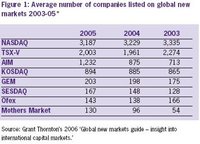| Dual listings on smaller markets grow in popularity |
Back |
| With Ireland’s stock market for smaller companies, the Irish Enterprise Exchange (IEX), up and running for over a year now, Ian McDonald takes a look at other smaller markets around the world, and finds that, like companies listing on the IEX who also choose to list on London’s Alternative Investments Market (AIM), dual listings are becoming more widespread as companies seek safer ways to explore a listing on an international market. |
At the end of 2005 there were 33 new markets around the world, offering listing prospects to young, small and typically technology-focussed companies with high growth potential. These new markets contrast with the main markets, which suit larger, more established companies across a broad range of industry sectors.  | | Average number of companies listed on global new markets 2003-05 |
Choosing a market
New markets have, in the past, primarily appealed to locally based and smaller companies. Many of those companies, despite having international operations and clients, have struggled to attract international investors. However, with increasing numbers of companies opting for dual listings or listing internationally, the tide may be turning.
Market performances
2005 was a turbulent year for several of the new markets, with market index performance declining in the first quarter, before recovering sporadically. At the end of the year, all markets had recovered, with KOSDAQ growing by 85 per cent and TSX-V by 23 per cent. Over the last three years (2003-2005) all markets have grown significantly, with the exception of GEM, which declined by 1 per cent. KOSDAQ, NASDAQ and SESDAQ experienced index growth of over 60 per cent, while AIM grew by 80 per cent and TSX-V by 100 per cent over the period.
Growth markets continue to offer favourable conditions for fledgling and high growth companies, with global new markets supporting companies with a combined market capitalisation of $4,222 billion during 2005. The trend for polarisation within these exchanges is evident, however, and the past three years has seen clear blue water separate NASDAQ, TSX-V and AIM from other new markets in terms of companies listed, according to Grant Thornton’s 2006 ‘Global new markets guide - insight into international capital markets.’
Despite a decline in year-on-year growth, NASDAQ continued its three-year lead with 3,187 companies listed in 2005, while TSX-V witnessed an increase of 2 per cent. AIM grew by 41 per cent, with 1,232 companies listed and can be seen as one of the star performers of the year. Steady year-on-year growth has also been recorded for Korea’s KOSDAQ and, elsewhere in the Asia Pacific region, Singapore’s SESDAQ supported 167 companies - an increase of 13 per cent on 2004.
We are now seeing a jostling for position in the world’s global new markets. The consolidation story played out in the international capital markets is now running in new markets. Each is seeking to attract premium listings and NASDAQ, AIM and TSX-V are setting a steady pace to follow.
Dual listings become more widespread
Dual listings are becoming more widespread as companies seek safer ways to explore a listing on an international market. Some companies are driven by poor liquidity in home markets, while others seek the opportunity to gain access to a larger investor base with a larger pool of capital available for investment, and some are attracted to the regulatory structure of international markets. Certainly AIM, one of the star performers of 2005, has been particularly successful in this regard and achieved a staggering 73 per cent year-on-year increase in market capitalisation ($78 billion 2005: $45 billion 2004).
Market liquidity
Liquidity, or the ease with which stocks can be traded, is the lifeblood of any market. A liquid market provides the best environment for companies to reflect their true market value in their share prices. Those new markets that attract smaller companies or that have a small number of listed companies tend to have lower liquidity. Smaller companies often retain a large percentage of shares among a close group of managers or owners, leaving less free capital in the market than is necessary to provide enough free float for unrestricted buying and selling.
The Asian exchanges of KOSDAQ and Mothers Market led the charge for market liquidity, recording a significant 75 per cent and 39 per cent, respectively, for turnover of shares as a percentage of total market capitalisation. For others, though, markets have been persistently illiquid. SESDAQ saw liquidity decline for the third year running, as did Hong Kong’s GEM.
The onward march of China is, however, not affecting the main exchanges and the Hong Kong Stock Exchange, one of the top ten exchanges in the world in terms of market capitalisation and funds raised, continues its prosperous growth. Market capitalisation has grown from $460 billion in January 2003 to $1,260 billion in June 2006. Total funds raised through initial public offerings and the secondary market have increased from $27 billion for 2003 to $39 billion in 2005.
China has enjoyed uninterrupted and phenomenal economic growth in the past few years. For the first six months of 2006, total funds raised on the Hong Kong Stock Exchange reached $23 billion, of which GEM accounted for $828 million. India too is enjoying the regional upswing and capitalisation on the National Stock Exchange has increased a phenomenal 152 per cent over two years to stand at $667 billion. Results in both countries are buoyed by substantial international interest and this looks set to continue throughout 2006.
Ian McDonald is a manager in Grant Thornton.
Information featured in figure 1 is based on the calculated average number of companies listed in each month of the year. |
|
| Article appeared in the October 2006 issue.
|
|